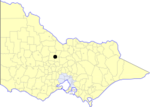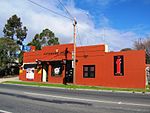Loddon Mallee

The Loddon Mallee is an economic rural region located in the north-western part of Victoria, Australia. Occupying more than a quarter of the state, it stretches from Greater Melbourne to the northernmost point of Victoria, sharing a border with South Australia and New South Wales, and has one of the most consistently warm climates in Victoria. It has two major regional cities Bendigo and Mildura and also contains the major settlements of Castlemaine, Echuca, Gisborne, Kerang, Kyneton, Maryborough, Swan Hill, Wedderburn and Wycheproof. Comprising an area in excess of 58,000 square kilometres (22,000 sq mi) this is the largest region in Victoria hosting a population of over 348,000 people. The Loddon Malle region includes the Shire of Buloke, Shire of Campaspe, Shire of Central Goldfields, Shire of Gannawarra, City of Greater Bendigo, Shire of Loddon, Shire of Macedon Ranges, Rural City of Mildura, Shire of Mount Alexander and Rural City of Swan Hill local government areas. The Loddon Mallee region is located along two major transport corridors, the Calder Highway corridor linking Melbourne to Bendigo and Mildura and the interstate Sturt Highway corridor linking Sydney to Mildura and Adelaide. The region comprises two distinct and inter-connected sub-regions or districts: Loddon Campaspe and Mallee.
Excerpt from the Wikipedia article Loddon Mallee (License: CC BY-SA 3.0, Authors, Images).Loddon Mallee
Bannerman Street, Bendigo
Geographical coordinates (GPS) Address Nearby Places Show on map
Geographical coordinates (GPS)
| Latitude | Longitude |
|---|---|
| N -36.75 ° | E 144.26666666667 ° |
Address
Bannerman Street
Bannerman Street
3550 Bendigo (Bendigo)
Victoria, Australia
Open on Google Maps





